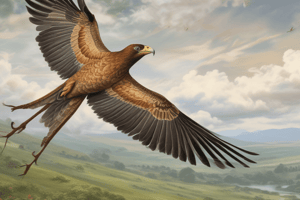Podcast
Questions and Answers
In 'The Windhover', what literary device does the poet use to convey excitement in the poem?
In 'The Windhover', what literary device does the poet use to convey excitement in the poem?
Caesura in the form of an exclamation mark
In 'The Windhover', what effect does the anadiplosis in the sentence 'off, off' create?
In 'The Windhover', what effect does the anadiplosis in the sentence 'off, off' create?
A striking sense of movement, allowing the reader to imagine the bird climbing higher
In 'The Windhover', what literary device does the poet use to describe the windhover's curving path?
In 'The Windhover', what literary device does the poet use to describe the windhover's curving path?
Simile, comparing the windhover's path to a skate's heel sweeping smooth on a bow-bend
In 'The Windhover', what is the effect of the capitalization of 'AND' in the line 'AND the fire that breaks from thee then...'?
In 'The Windhover', what is the effect of the capitalization of 'AND' in the line 'AND the fire that breaks from thee then...'?
In 'The Windhover', what is the significance of the final line 'Fall, gall themselves, and gash gold-vermillion'?
In 'The Windhover', what is the significance of the final line 'Fall, gall themselves, and gash gold-vermillion'?
Flashcards are hidden until you start studying
Study Notes
The Poem "The Windhover"
- The poem focuses on a single element of the natural world, a windhover or falcon, to display the beauty of creation and the natural world through imagery.
Themes and Ideas
- The beauty of the airborne creature
- Celebration of the natural world
- God's divine power
- Mankind's connection with nature
- Nature as a restorative force
Poetic Style
- Intensely detailed imagery
- Complex language
- Compound words
- Euphonic sound effects
- Caesura
- Enjambment
Key Quotes and Analysis
- "I caught this morning morning's minion king- / dom of daylight's dauphin dapple-dawn-drawn Falcon in his riding"
- Use of ellipsis captures poet's excitement
- Repetition of "morning" creates movement
- Compound words "dapple-dawn-drawn" create sense of falcon's appearance and connection to nature
- "Of the rolling level underneath him steady air, and striding / High there how he rung upon the rein of a wimpling wing"
- Enjambment focuses on the airborne creature
- Alliteration adds to poet's delight
- "Then off, off forth on swing, / The heightened experience... in ecstasy!"
- Anadiplosis creates sense of movement
- Caesura captures poet's excitement
- "As a skate's heel sweeps smooth on a bow-bend: the hurl and gliding / Rebuffed the big wind."
- Simile allows us to imagine windhover's curving path
- Sibilance creates euphonic sound effects
- "Brute beauty and valour and act, oh, air, pride, plume, here / Buckle!"
- Swift use of monosyllables quickens pace
- Capitalisation of 'AND' arrests attention
- "AND the fire that breaks from thee then, a billion / Times told lovelier, more dangerous, O my chevalier!"
- Hyperbolic exclamation showcases poet's admiration
- "Fire" could be red plumage of the bird
- "No wonder of it: sheer plod makes plough down sillion / Shine, and blue-bleak embers, ah my dear, / Fall, gall themselves, and gash gold-vermillion."
- Poet realises seemingly mundane work and effort are what make beauty shine
- Focus remains on beauty of the bird, dedicated to 'Christ our Lord'
Studying That Suits You
Use AI to generate personalized quizzes and flashcards to suit your learning preferences.


